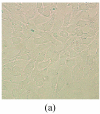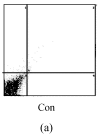Edaravone protects PC12 cells from ischemic-like injury via attenuating the damage to mitochondria
- PMID: 16909478
- PMCID: PMC1559792
- DOI: 10.1631/jzus.2006.B0749
Edaravone protects PC12 cells from ischemic-like injury via attenuating the damage to mitochondria
Abstract
Background: Edaravone had been validated to effectively protect against ischemic injuries. In this study, we investigated the protective effect of edaravone by observing the effects on anti-apoptosis, regulation of Bcl-2/Bax protein expression and recovering from damage to mitochondria after OGD (oxygen-glucose deprivation)-reperfusion.
Methods: Viability of PC12 cells which were injured at different time of OGD injury, was quantified by measuring MTT (2-(4,5-dimethylthia-zol-2-yl)-2,5-diphenyltetrazolium bromide) staining. In addition, PC12 cells' viability was also quantified after their preincubation in different concentration of edaravone for 30 min followed by (OGD). Furthermore, apoptotic population of PC12 cells that reinsulted from OGD-reperfusion with or without preincubation with edaravone was determined by flow cytometer analysis, electron microscope and Hoechst/PI staining. Finally, change of Bcl-2/Bax protein expression was detected by Western blot.
Results: (1) The viability of PC12 cells decreased with time (1 - 12 h) after OGD. We regarded the model of OGD 2 h, then replacing DMEM (Dulbecco's Modified Eagle's Medium) for another 24 h as an OGD-reperfusion in this research. Furthermore, most PC12 cells were in the state of apoptosis after OGD-reperfusion. (2) The viability of PC12 cells preincubated with edaravone at high concentrations (1, 0.1, 0.01 micromol/L) increased significantly with edaravone protecting PC12 cells from apoptosis after OGD-reperfusion injury. (3) Furthermore, edaravone attenuates the damage of OGD-reperfusion on mitochondria and regulated Bcl-2/Bax protein imbalance expression after OGD-reperfusion.
Conclusion: Neuroprotective effects of edaravone on ischemic or other brain injuries may be partly mediated through inhibition of Bcl-2/Bax apoptotic pathways by recovering from the damage of mitochondria.
Figures




























Similar articles
-
Anti-apoptotic and neuroprotective effects of edaravone following transient focal ischemia in rats.Eur J Pharmacol. 2005 Jun 1;516(2):125-30. doi: 10.1016/j.ejphar.2005.04.036. Eur J Pharmacol. 2005. PMID: 15921675
-
Role of Bcl-2 family of proteins in mediating apoptotic death of PC12 cells exposed to oxygen and glucose deprivation.Neurochem Int. 2005 Jan;46(1):73-81. doi: 10.1016/j.neuint.2004.06.006. Neurochem Int. 2005. PMID: 15567517
-
Protective effect of edaravone against renal ischemia/reperfusion injury and compared with ischemic postconditioning in rats.Yao Xue Xue Bao. 2010 Jul;45(7):840-8. Yao Xue Xue Bao. 2010. PMID: 20931780
-
Neuroprotection by NGF in the PC12 in vitro OGD model: involvement of mitogen-activated protein kinases and gene expression.Ann N Y Acad Sci. 2005 Aug;1053:84-96. doi: 10.1196/annals.1344.008. Ann N Y Acad Sci. 2005. PMID: 16179511 Review.
-
Neuroprotective Effects of Bioactive Compounds and MAPK Pathway Modulation in "Ischemia"-Stressed PC12 Pheochromocytoma Cells.Brain Sci. 2018 Feb 8;8(2):32. doi: 10.3390/brainsci8020032. Brain Sci. 2018. PMID: 29419806 Free PMC article. Review.
Cited by
-
Protective Effect of Edaravone in Primary Cerebellar Granule Neurons against Iodoacetic Acid-Induced Cell Injury.Oxid Med Cell Longev. 2015;2015:606981. doi: 10.1155/2015/606981. Epub 2015 Oct 18. Oxid Med Cell Longev. 2015. PMID: 26557222 Free PMC article.
-
Carnosic Acid Shows Higher Neuroprotective Efficiency than Edaravone or Ebselen in In Vitro Models of Neuronal Cell Damage.Molecules. 2023 Dec 24;29(1):119. doi: 10.3390/molecules29010119. Molecules. 2023. PMID: 38202702 Free PMC article.
-
Survivin is involved in the anti-apoptotic effect of edaravone in PC12 cells.Mol Cell Biochem. 2009 Jul;327(1-2):21-8. doi: 10.1007/s11010-009-0037-1. Epub 2009 Feb 18. Mol Cell Biochem. 2009. PMID: 19224341
-
Protective Effect of Edaravone on Glutamate-Induced Neurotoxicity in Spiral Ganglion Neurons.Neural Plast. 2016;2016:4034218. doi: 10.1155/2016/4034218. Epub 2016 Nov 10. Neural Plast. 2016. PMID: 27957345 Free PMC article.
-
Study on norcantharidin-induced apoptosis in SMMC-7721 cells through mitochondrial pathways.Chin J Integr Med. 2010 Oct;16(5):448-52. doi: 10.1007/s11655-010-0538-5. Epub 2010 Sep 25. Chin J Integr Med. 2010. PMID: 20872120
References
Publication types
MeSH terms
Substances
LinkOut - more resources
Full Text Sources
Research Materials
Miscellaneous

